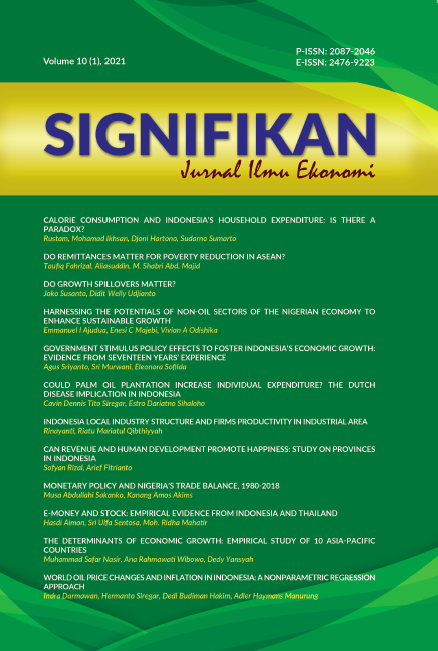Could Palm Oil Plantation Increase Individual Expenditure? The Dutch Disease Implication in Indonesia
DOI:
https://doi.org/10.15408/sjie.v10i1.15831Keywords:
Individual Expenditure, Manufacture to Service Ratio, Natural-Resource Abundance, Palm Oil Production, The Dutch DiseaseAbstract
Indonesia is the largest palm-oil producing country, covering almost 80 percent of global production. With the extensive production capacity, this research seeks to analyze the linkages between palm oil production and its impact on the economy by the individual monthly expenditure. To reveal the connections, this research analyzes the Dutch Disease phenomenon in Indonesia, which explains how the non-tradable sector, palm-oil industry, affects the tradable sector like the manufacturing industry. The panel data variables are selected from 2011 to 2015 within 22 provinces to see the Dutch Disease's implications. As the model is suffered from the endogeneity, the correlation of explanatory variables with the error term, the research uses the Instrumental-Variable Regression method. The analysis indicates that Indonesia was not suffered from Dutch Disease. Therefore, palm oil production could increase individual expenditure. Finally, the extension of palm oil plantations could benefit Indonesia's economy without affecting other sectors.
JEL Classification: E21, E24, O13, O44
How to Cite:Siregar, C. D. T., & Sihaloho, E. D. (2021). Could Palm Oil Plantation Increase Individual Expenditure? The Dutch Disease Implication in Indonesia. Signifikan: Jurnal Ilmu Ekonomi, 10(1), 77-92. doi: http://doi.org/10.15408/sjie.v10i1.15831.
References
Alston, J. M., & Pardey, P. G. (2014). Agriculture in the Global Economy. Journal of Economic Perspectives, 28(1), 121-146. https://doi.org/10.1257/jep.28.1.121
Aprina, H. (2014). The Impact of Crude Palm Oil Price On Rupiah's Rate. Buletin Ekonomi Moneter Dan Perbankan, 16(4), 295-314. https://doi.org/10.21098/bemp.v16i4.448
Baudoin, B. P.M., Bessou, C., Levang, P., A. (2017). Review of the Diversity of Oil Palm System in Indonesia: Case Study of Two Provinces: Riau and Jambi. Working Paper Center for International Forestry Research, 23, 1-84. https://doi.org/10.17528/cifor/006462 Baudoin
Behzadan, N., Chisik, R., Onder, H., & Battaile, B. (2017). Does Inequality Drive the Dutch Disease? Theory and Evidence. Journal of International Economics, 106, 104-118. https://doi.org/10.1016/j.jinteco.2017.02.003
Bietenbeck, J., Ericsson, S., & Wamalwa, F. M. (2019). Preschool Attendance, Schooling, and Cognitive Skills in East Africa. Economics of Education Review, 73, 1-15. https://doi.org/10.1016/j.econedurev.2019.101909
Boyce, J. R., & Herbert Emery, J. C. (2011). Is a Negative Correlation Between Resource Abundance and Growth Sufficient Evidence That There is a “Resource Curse”? Resources Policy, 36(1), 1-13. https://doi.org/10.1016/j.resourpol.2010.08.004
Brahmbhatt, M., Canuto, O., & Vostroknutova, E. (2010). Dealing with Dutch Disease. Economic Premise, 16, 1-7.
Budidarsono, S., Dewi, S., Sofiyuddin, M., & Rahmanulloh, A. (2012). Socio-economic Impacts Assessment of Palm Oil Production. Technical Brief: Oil Palm Series, 27, 1-4.
Bui, A. T., Dungey, M., Nguyen, C. V., & Pham, T. P. (2014). The Impact of Natural Disasters on Household Income, Expenditure, Poverty, and Inequality: Evidence from Vietnam. Applied Economics, 46(15), 1751-1766. https://doi.org/10.1080/00036846.2014.884706
Cai, Z., & Wang, Y. (2014). Testing Predictive Regression Models with Nonstationary Regressors. Journal of Econometrics, 178(1), 4-14. https://doi.org/10.1016/j.jeconom.2013.08.002
Choong, C. G., & McKay, A. (2014). Sustainability in the Malaysian Palm Oil Industry. Journal of Cleaner Production, 85, 258-264. https://doi.org/10.1016/j.jclepro.2013.12.009
Coxhead, I., & Shrestha, R. (2016). Could a Resource Export Boom Reduce Workers’ Earnings? The Labour-Market Channel in Indonesia. Bulletin of Indonesian Economic Studies, 52(2), 185-208. https://doi.org/10.1080/00074918.2016.1184745
Damuri, Y. R. (2016). Services Sector Development in Indonesia and the Implementation of AEC Measures in Services. CSIS Working Paper Series.
Directorate General of Plantation. (2015). Statistik Perkebunan Indonesia 2014-2016: Kelapa sawit. Tree Crop Estate Statistics of Indonesia.
Edwards, R. (2015). Is Plantation Agriculture Good for the Poor? Evidence from Indonesia’s Palm Oil Expansion. Working Papers No. 2015/12. Australian National University.
Ehinomen, D. C. (2012). Exchange Rate Management and the Manufacturing Sector Performance in the Nigerian Economy. IOSR Journal of Humanities and Social Science, 5(5), 1-12. https://doi.org/10.9790/0837-0550112
Gaskell, J. C. (2015). The Role of Markets, Technology, and Policy in Generating Palm-Oil Demand in Indonesia. Bulletin of Indonesian Economic Studies, 51(1), 29-45. https://doi.org/10.1080/00074918.2015.1016566
Kementerian Pendidikan dan Kebudayaan. (2019). Indeks Aktivitas Literasi Membaca 34. http://repositori.kemdikbud.go.id/13033/1/Puslitjakdikbud_Indeks Aktivitas Literasi Membaca 34 Pr
Loizou, E., Karelakis, C., Galanopoulos, K., & Mattas, K. (2019). The Role of Agriculture as a Development Tool for a Regional Economy. Agricultural Systems, 173, 482-490. https://doi.org/10.1016/j.agsy.2019.04.002
McCarthy, J. F. (2010). Processes of Inclusion and Adverse Incorporation: Oil Palm and Agrarian Change in Sumatra, Indonesia. Journal of Peasant Studies, 37(4), 821-850. https://doi.org/10.1080/03066150.2010.512460
Molla, A. A., Chi, C., & Mondaca, A. L. N. (2017). Predictors of High Out-of-pocket Healthcare Expenditure: an Analysis Using Bangladesh Household Income and Expenditure Survey, 2010. BMC Health Services Research, 17(94), 1-8. https://doi.org/10.1186/s12913-017-2047-0
Navickas, M., Gudaitis, T., & Krajnakova, E. (2014). Influence of Financial Literacy on the Management of Personal Finances in a Young Household. Business: Theory and Practice, 15(1), 32-40. https://doi.org/10.3846/btp.2014.04
Nikzadian, A., Agheli, L., Arani, A. A., & Sadeghi, H. (2019). The Effects of Resource Rent, Human Capital, and Government Effectiveness on Government Health Expenditure in the Organization of the Petroleum Exporting Countries. International Journal of Energy Economics and Policy, 9(2), 381-389. https://doi.org/10.32479/ijeep.7575
PASPI, T. R. (2015). Kontribusi Industri Minyak Sawit dalam Pencapaian Sustainable Development Goals 2030 Indonesia. Monitor PASPI.
Prasetyia, F. (2019). The Role of Local Government Policy on Secondary School Enrolment Decisions in Indonesia. Eurasian Economic Review, 9, 139–172. https://doi.org/10.1007/s40822-018-0101-9
Sun, H. Ping, Sun, W. Feng, Geng, Y., Yang, X., & Edziah, B. K. (2019). How Does Natural Resource Dependence Affect Public Education Spending? Environmental Science and Pollution Research, 26, 3666–3674. https://doi.org/10.1007/s11356-018-3853-6
Susanti, A., & Burgers, P. (2011). Oil Palm Expansion in Riau Province, Indonesia: Serving People, Planet, Profit?Utrecht University Repository.
Taguchi, H., & Khinsamone, S. (2018). Analysis of the ‘Dutch Disease’ Effect on the Selected Resource-Rich ASEAN Economies. Asia and the Pacific Policy Studies, 5(2), 249-263. https://doi.org/10.1002/app5.233
Vivek, V. B. S. C. L. (2019). Global Market Report. Exchange Organizational Behavior Teaching Journal, 62, 1-10.


